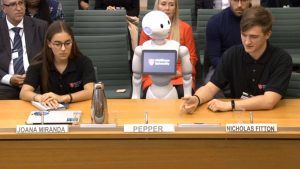Time flies when you’re trying to keep up with the robotics and automation industry. As 2018 is coming to an end Active8 Robots is preparing for another big year in 2019.
Robotics is now affecting multiple industries and is no longer limited to automation. It is becoming part of our daily lives and that was reflected when the UR10 rang the bell for the New York Stock Exchange and Pepper taking the stand in Parliament in the UK.

The Rise of Cobots
Cobots are on the up, and they are here to stay. Universal Robots continue to dominate the industry, as they seem to have mastered the art of collaborative robotic arms. They don’t try and venture out into grippers or sensors, but instead do what they do well and allow their partners to concentrate on the other aspects of robotics. This became even more true when they were acquired by Teradyne, who also own Mobile industrial Robots (MiR). These partnerships mean universal are now part of a strong robotics ecosystem. There are however, people doing other things within the cobot world, such as Franka Emika who have created the Panda Robot which has 7 axes. On top of this there are an increasing amount of industrial robot manufacturers who are venturing out into, or expanding on their section within, the collaborative robot market, such as ABB and FANUC.
Cobot Safety
As for the safety of cobots, new sensors are making cobots and industrial robots safer. Features of cobots are now filtering out to larger industrial automation world, making industrial robots safer, but still by no means safe. This is a message that has been repeated over and over in 2018, but should be reiterated further in 2019; just because cobots are safer than industrial robots, they can still be dangerous depending on the application.
The fall of Rethink
Sawyer and Baxter were popular, ground-breaking, revolutionary cobots. On top of this, they were a big part of Active8 Robots’ history. The fall of Rethink Robotics proves just how high consumer expectations are within the robotics industry, but Active8 Robots was pleased to hear that the brand will live on through Hahn Group.
Self Driving Cars
Although some huge developments have been made in the automotive industry this year, there have also been some huge red flags. Sadly there was the first fatality from Uber, as well as some accidents from Tesla, however it is thought that most of these were cause by human error. Some places in the US already have automated cars, however these still have drivers.
Mobile Robots
Mobile robots have become even more prominent in warehouses such as Ocado and Amazon. With the labour shortage, more prominent than ever with Brexit looming closer, companies have found it more and more difficult to retain staff in repetitive and straining jobs. The robots aren’t just filling labour shortages either, but are improving efficiency too, as they can complete the tasks at a faster rate.
2019
As for next year, robot and cobot development shows no sign of slowing down. In 2019, the focus for manufacturers will shift towards accelerated creation and deployment of more capable robots with advanced features and functions. Cobotswill also become increasingly popular in manufacturing operations. For example, it’s common in car plants today for humans to remain separate from robots on the plant floor. Machines moving parts of the car frame will automatically stop if human workers cross a barrier separating the two. However, in the not-too-distant future, given advances in technologies like machine vision and machine learning, cobots will be able to move in the same space as human workers.
Cobots are becoming a viable option for manufacturing operations largely because of their low-end price points, flexibility, and constantly evolving capabilities. Because of this, it’s going to be crucial that robots and cobots meet safety requirements, especially given they will be inter-operating with humans. Cobots are tailored to ISO standards with regards to safety, yet because of their functionality, industry must develop further safety standards. For example, cobots have defined speeds of motion. If you surpass designated speeds, then cobots can’t inter-operate with humans because they can create and cause damage.
If manufacturers start making more capable cobots and have them handling bigger task loads, they become stronger and more capable of damage. That’s why the safety element becomes important. Manufacturers want cobots to be able to move within the same space as humans, but they certainly don’t want them banging into or hurting them in any way. Safety concerns surrounding big robots can be addressed by exclusion. For cobots, you must be much more careful.
